What is CdLS?
What is Cornelia de Lange Syndrome (CdLS)?
Cornelia de Lange Syndrome (CdLS) is a genetic disorder present from birth, usually not inherited. It is usually due to an acquired change (mutation) in one of seven important developmental genes at or shortly after conception. The signs of CdLS may be obvious from birth or even prenatally, especially if severely involved, but may not be diagnosed until the child is older when it is milder. It causes such a broad range of potential physical, cognitive and medical challenges that it is now known as the CdLS spectrum disorder. CdLS does not discriminate— it affects both genders equally and it’s seen in all races and ethnic backgrounds. The occurrence of CdLS is estimated to be 1 in 10,000 live births, but because it is so variable, could remain undiagnosed. It typically affects: growth, with smaller body and head size; skeletal system, with smaller hands and feet or missing forearms and fingers; development, with delayed development, intellectual disability or learning disabilities; behavior, with ADHD, anxiety or autistic features; and internal body organs including the GI, cardiac, genitourinary and neurologic body systems. Testing for the gene change will be positive in about 80% of individuals with CdLS, but a clinical evaluation with a geneticist should be diagnostic.
Foundation staff is available by phone or email to offer support, connect you with other families, and provide information from medical, educational and behavioral experts.
Where should I go from here?
You can reach out to our caring and knowledgeable Family Service Coordinators. They can provide individuals with Cornelia de Lange Syndrome (CdLS) and their families a wealth of services, support and information. Most of the services the team provides are free of cost. The calls or emails received by our support team are answered by caring professionals who listen, answer questions and offer individualized support.
Contact the Foundation to request our free packet, Starting the Journey: Information and Support for New Parents. This packet of basic information helps you and your child—no matter how he or she is—receive the best start possible. It addresses topics related to growth and feeding, education, genetic information, and much more.

Characteristics of CdLS
As with many other syndromes, individuals with CdLS strongly resemble one another. Typical facial features include thin eyebrows that meet in the middle, long eyelashes, a short upturned nose, and thin downturned lips.
Other characteristics include low birth weight (often under five pounds), slow growth, small stature, and small head size. Other features may include excessive body hair and small hands and feet. Common medical issues include gastro- esophageal reflux disease, heart defects, seizures, feeding difficulties, vision problems, and hearing loss. Limb differences, including missing arms, forearms or fingers, are seen in about 25 percent of individuals with CdLS. Behavioral and communication issues and developmental delays often exist.

Diagnosis of CdLS
The diagnosis of CdLS is primarily a clinical one based on signs and symptoms observed through an evaluation by a physician, including a medical history, physical examination and laboratory tests. However, genetic testing can be helpful in confirming the clinical diagnosis and assessing which gene is involved.
Although seven separate gene mutations have been identified as causing CdLS, not every person tests positive for one of these gene changes. If you suspect your child has CdLS, a genetic specialist can help.

Frequently Asked Questions
If you are just learning about your child’s diagnosis, then you have many questions. The Foundation Medical Director has answered some of the most common and basic questions about the syndrome.
Know Your Genes
Discovery of genetic information in CdLS helps to better understand why, and how, CdLS happens, as well as why it varies so widely from one individual to another.
In 2004, researchers at the Children’s Hospital of Philadelphia and the University of Newcastle upon Tyne (England), identified a gene (NIPBL) on chromosome 5 that causes CdLS when it is mutated. Since then, additional genes have been found (SMC1A, SMC3, HDAC8, RAD21, ANKRD11, BRD4) that cause CdLS when changed. Families will receive results about a specific mutation (variant) in a specific gene that led to the CdLS. There are other known genes that, when variants are present, can cause conditions that resemble CdLS (e.g. AFF4, TAF1, ASXL1), and there are likely to be more. Researchers hope to gain a better understanding of why CdLS varies so widely from one individual to another and what can be done to improve the quality of life for people with the syndrome.
Medical Home Portal
The Medical Home Portal is a website of reliable information about individuals with special health care needs. The site offers a “one-stop shop” for their families; medical, educational and therapeutic professionals; as well as other community members involved in their care.

